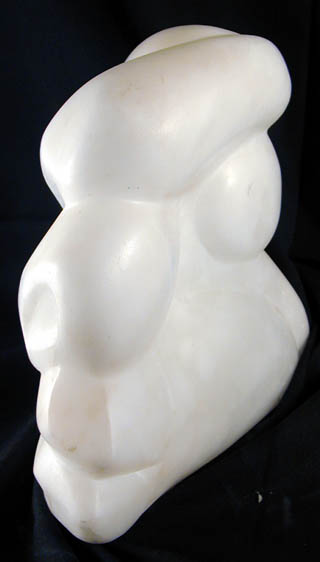 This is not as easy as it might seem. But not to worry, if you happen to jump to the next grade of sandpaper too soon there is one sure fire method to test your progress and determine if you need to bump back to a previous grade of sandpaper.
This is not as easy as it might seem. But not to worry, if you happen to jump to the next grade of sandpaper too soon there is one sure fire method to test your progress and determine if you need to bump back to a previous grade of sandpaper.
After you graduate to 320 sandpaper, it is time to let your sculpture dry and look at it under a strong light.
The sculpture to the right was more than a bit of a bear to polish. It took my quite some time before I could find and remove all of the scars from the crevices. That is what drying will bring to light — scars and scratches.
When you let the sculpture dry and look at it under good light, you will find all of the scratches and scars left by the chisel and rasp. Scratches are a natural result caused by the use of chisel and rasp.
When the sculpture is close to its final form I wills top using chisel and switch to course rasp. The course rasp is useful in the process of shaping and in the process of removing scars left by the chisel.
When the sculpture is even closer to the final form I will switch to a medium rasp. The medium rasp is useful in the process of further refining the shape of the sculpture and in the process of removing scars left by the course rasp.
After the initial shaping of the sculpture each stage requires more and more delicate tools — leading from hammer and chisel to 1500 grit sandpaper. While shaping is the main goal of each stage of the sculpting process, removing the traces of work from the previous stage is the other equally important goal.
By the time you get to 320 grit sandpaper shaping is done. Now it is all a process of removing traces of work and achieving an appropriate surface for the sculpture. In the case of my sculptures that is smooth — real smooth.
If when studying the dry sculpture in the light one notices a scratch or scar, then one simply reverts to a previous grit of sandpaper to remove that scratch. Depending upon the depth of the scratch one can just bump up to 220 — or it might be necessary to go back to 120. If you find it necessary to revert to the use of a rasp, then you jumped into the polishing process a little too early.
After fixing the scratch, proceed with the 320 again, dry the sculpture and study it again.
Sand, rinse, dry, study and repeat as necessary.
When you move on to the 400 grit sandpaper you should have zero worries about scratches. From this point on it is all a matter of polishing.

